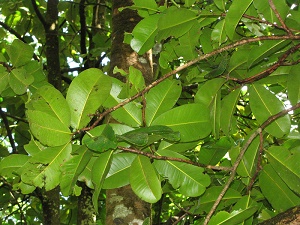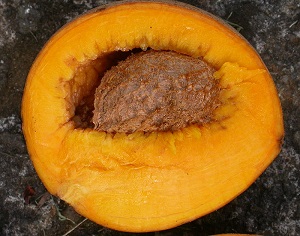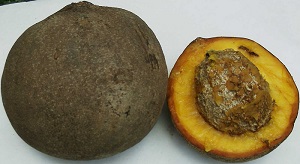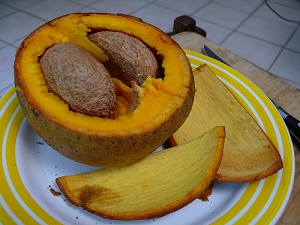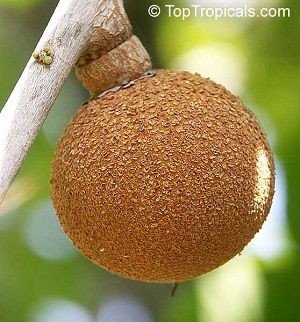| Mammey Apple - Mammea americana | |||||||||||
|---|---|---|---|---|---|---|---|---|---|---|---|
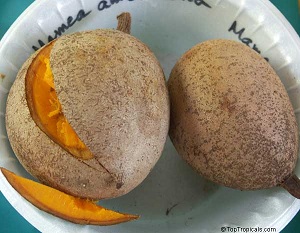 Fig. 1  Mammea americana L. 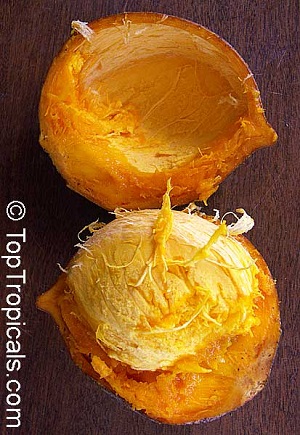 Fig. 2  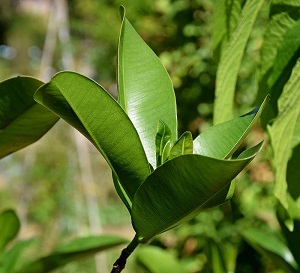 Fig. 3  M. americana in Jardin des Plantes de Toulouse 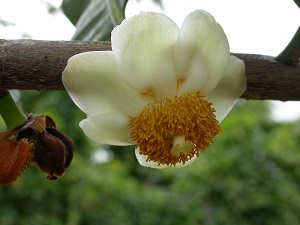 Fig. 5  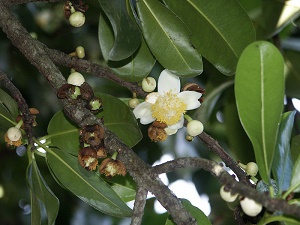 Fig. 6  M. americana cultivated, Fairchild Tropical Botanic Garden, Miami, Florida, USA 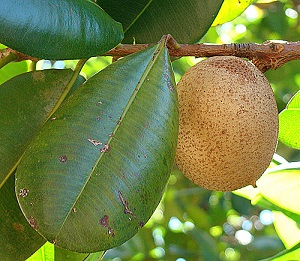 Fig. 7  M. americana, the mammee apple 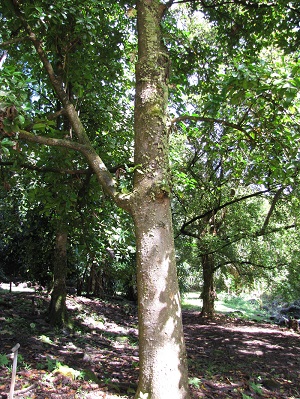 Fig. 12  M. americana (mammee apple, mamey) trunk. Keanae Arboretum, Maui, Hawai'i. 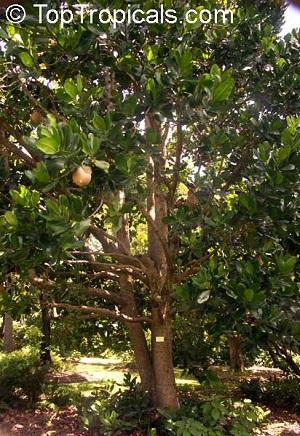 Fig. 13  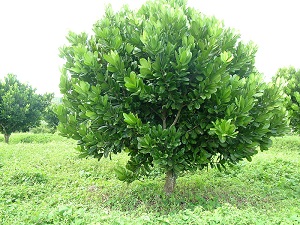 Fig. 14  Young grafted tree planted in an orchard |
Scientific
name Mammea americana L. Common names English: mammee, mammee apple, mammy-apple, St. Domingo apricot and south American apricot; Spanish: mamey de Santo Domingo, mamey amarillo, mamey de Cartagena, mata serrano, zapote mamey, or zapote de Santo Domingo; Portuguese: abricote, abrico do Pará, abrico selvagem, or pecego de Sao Domingos; French: abricot d' Amerique, abricot des Antilles, abricot pays, abricot de Saint-Dominque or abricotier sauvage 1 Synonym M. emarginata Moc. & Sesse ex Choisy Family Calophyllaceae also placed in Clusiaceae (formely Guttiferae) Origin Native to the West Indies and northern south America Uses Eaten fresh; made into preserves; used as filler for products made of other fruits; lightly under-ripe fruits, rich in pectin, are made into jelly; planted as a shade and wind breaker 3 Height 60-70 ft (18-21 m) 1 Plant habit Naturally forms a pyramidal, pleasing canopy 2 Trunk/bark/branches Short trunk that may attain 0.9-1.2 m in diameter; ascending, densely foliaged; branches forming an erect, oval head 3 Leaves Dense foliage; large, glossy, leathery leaves of hunter green 2 Flower Solitary or grouped on fasciles; male, female and hermaphrodite together or on separate trees 1 Fruit Large drupe; thick, rugose skin; flavor of apricot and berries Season In southern Florida, mameys ripen from late June through July and August 1 USDA Nutrient Content pdf Light requirement Full Sun Soil tolerances Quite adaptable to a wide range of soils Drought tolerance Moderate Aerosol salt tolerance Unknown Soil salt tolerance Unknown Cold tolerance Damage 30 °F (-1.1 °C) Invasive potential * None reported Pest/disease resistance Very few pests or diseases affect the mammee apple in south Florida 5 Roots Large spreading lateral roots prevent soil erosion 3 Known hazard All parts of the mamey have insecticidal properties; the juice of the seed leaves an indelible stain 3 Can produce discomfort, especially in the digestive system, in some persons. 1 Reading Material Collecting Mammea americana L. in Tropical America: Potensial for Florida, Fairchild Tropical Botanic Garden pdf Mamey, Fruits of Warm Climates The Tropical Apricot in South Florida, Fairchild Tropical Botanic Garden Mammea americana, Agroforestree Database The Mammey, Mammea americana L., Manual Of Tropical And Subtropical Fruits The tropical apricot (Mammea americana) is one of the best kept tropical fruit secrets of Tropical America. No relation to the true temperate apricot of the northern climes, this fruit is a bit of a challenge, but worth the effort. The tree is a great asset in the home landscape that will provide a point of pride among your neighbors. 2 The generic name is from a West Indian name, ‘mammey’ for a member of the genus. The specific epithet means ‘of American origin’. 3 Origin Native to the West Indies and northern South America. Cultivated sporadically throughout the tropics. Description The mamey tree, handsome, reaches 60 to 70 ft (18-21 m) in height, has a short trunk which may attain 3 or 4 ft (0.9-1.2 m) in diameter, and ascending branches forming an erect, oval head, densely foliaged with evergreen, opposite, glossy, leathery, dark-green, broadly elliptic leaves, up to 8 in (20 cm) long and 4 in (10 cm) wide. The mamey is limited to tropical or near-tropical climates. In Central America, it thrives from near sea-level to 3,300 ft (1,000 m). Three trees at the Agricultural Research and Education Center, Homestead, in southern Florida, were killed by a temperature drop to 28º F (-2.22º C) in January 1940. 1 Leaves Densely foliaged with evergreen, opposite, glossy, leathery, dark-green, broadly elliptic leaves, up to 8 in (20 cm) long and 4 in (10 cm) wide. 1
Fig. 4. M. americana (mammee apple, mamey). Leaves at Keanae Arboretum, Maui, Hawai'i. Flowers The fragrant flowers, with 4 to 6 white petals and with orange stamens or pistils or both, are 1 to 1 1/2 in (2.5-4 cm) wide when fully open and borne singly or in groups of 2 or 3 on short stalks. They appear during and after the fruiting season: male, female and hermaphrodite together or on separate trees. 1 Seedlings generally will take from four to seven years before they even reach size where they can start to produce flowers. Once they finally begin to flower only male flowers may be produced for the first year or two; later, as the tree becomes more mature it will then start to produce both male and female flowers. 5 Fruit The fruit, nearly round or somewhat irregular, with a short, thick stem and a more or less distinct tip or merely a bristle-like floral remnant at the apex, ranges from 4 to 8 in (10-20 cm) in diameter, is heavy and hard until fully ripe when it softens slightly. The skin is light-brown or grayish-brown with small, scattered, warty or scurfy areas, leathery, about 1/8 in (3 mm) thick and bitter. Beneath it, a thin, dry, whitish membrane, or "rag", astringent and often bitter, adheres to the flesh. The latter is light- or golden-yellow to orange, non-fibrous, varies from firm and crisp. and sometimes dry to tender, melting and juicy. 1 The flesh is highly fragrant with a flavor of apricot and berries and can be eaten fresh or used to prepare jellies, preserves, or sherbets. The fruit is eaten while the flesh is still firm and the fruit will maintain their attractive flesh color for hours or even days. A cut fruit can be left on the kitchen counter and it will not brown. Now try that with apple or with the temperate apricot. 2 The fruit takes a year to mature. 3
Fig. 9. Full and longitudinally-cut mammee apples Harvesting Ripeness may be indicated by a slight yellowing of the skin or, if this is not apparent, one can scratch the surface very lightly with a fingernail. If green beneath, the fruit should not be picked, but, if yellow, it is fully mature. If fruits are allowed to fall when ripe, they will bruise and spoil. They should be clipped, leaving a small portion of stem attached. 1 Propagation Seeds are the usual means of dissemination and they germinate in 2 months or less and sprout readily in leaf-mulch under the tree. Seedlings bear in 6 to 8 years in Mexico, 8 to 10 years in the Bahamas. Vegetative propagation is preferable to avoid disappointment in raising male trees and to achieve earlier fruiting. In English greenhouse culture, half-ripe cuttings with lower leaves attached are employed. Both Robert Newcomb and Albert Caves of Palm Lodge Tropical Grove, Homestead, successfully grafted the mamey onto self-seedlings. 1 The best solution is to grow a grafted tree. Specialty nurseries in South Florida are beginning to propagate known female selections and these trees are becoming more common fare about town. At present the varieties ‘Redlands’ and ‘Kay Sweeney’ can be purchased on a routine basis. In the next few years there will be more quality selections coming available from local hobbyists and the Fairchild Tropical Botanic Garden. A quality grafted tree will fruit even in isolation, although a male tree in close proximity may improve yields. A grafted tree will begin to flower and fruit in three to five years after planting. 2 Culture The mamey tree favors deep, rich, well-drained soil, but is apparently quite adaptable to even shallow, sandy terrain, and it grows naturally in limestone areas of Jamaica, also does well in the oolitic limestone of the Bahamas and southeastern Florida. 1 Mamey coppices well and generally receives little or no cultural attention, apart from protection from cold during the first few winters in other than strictly tropical climates. 3 Addition of plant mulch to the soil surface will improve water-holding capacity, nutrient retention and availability and soil structure. 2 Fertilizing Fertilization is best done by three applications per year in March, July and September with an 8-3-9 or other fruit tree formulation. Do not fertilize after September, as you will make the tree more susceptible to cold damage. 2 Irrigation Young trees will prefer regular applications of water, but mature trees can do quite nicely with no watering. 2 Pest/disease A black mildew (Aulographum melioloides) attacks leaves and heart rot infects older trees entering through basal scars. Wet-wood termites attack dead trunks and branches and dry-wood termites attack seasoned lumber. 3 Food Uses To facilitate peeling, the skin is scored from the stem to the apex and removed in strips. The rag must be thoroughly scraped from the flesh which is then cut off in slices, leaving any part which may adhere to the seed, and trimming off any particles of seed-covering from the roughened inner surface of the flesh. 1 Sliced mamey flesh may also be cooked in pies or tarts, and may be seasoned with cinnamon or ginger. Canned, sliced mamey has in the past been exported from Cuba. The mamey is widely made into preserves such as spiced marmalade and pastes (resembling guava paste) and used as a filler for products made of other fruits. Slightly under-ripe fruits, rich in pectin, are made into jelly. Wine is made from the fruit and fermented "toddy" from the sap of the tree in Brazil.In the Dominican Republic, the uncooked flesh, blended with sugar, is made into frozen sherbet. The juice or sirup of stewed flesh, is seasoned with sugar and lemon juice to make "ade". When cooking the flesh for any purpose, one is advised to skim off any foam that forms on the surface of the water, as this is usually bitter. 1 In the French West Indies, an aromatic liqueur, Eau de Créole, or Crème de Créole, is distilled from the mammee flowers. This liqueur is believed to be tonic or digestive. 4 Medicinal Properties ** It is interesting to note that an antibiotic principle in the mamey was reported by the Agricultural Experiment Station, Rio Piedras, Puerto Rico, in 1951. 1 In Venezuela, the powdered seeds are employed in the treatment of parasitic skin diseases. In Brazil, the ground seeds, minus the embryo, which is considered convulsant, are stirred into hot water and the infusion employed as an anthelmintic for adults only.In the French West Indies, an aromatic liqueur called Eau de Creole, or Creme de Creole, is distilled from the flowers and said to act as a tonic or digestive. An infusion of the fresh or dry leaves (one handful in a pint [0.47 liter] of water) is given by the cupful over a period of several days in cases of intermittent fever and it is claimed to have been effective where quinine has failed. 1 Other Uses In Central America, the tree is protected because the fruit is valued. Elsewhere, if the mamey is common, it may be felled for its timber. The heartwood is reddish- or purple-brown; the sapwood much lighter in color. The wood is heavy, hard, but not difficult to work, fine-grained and strong; has an attractive grain and polishes well. It is useful in cabinetwork, valued for pillars, rafters, decorative features of fine houses, interior sheathing, turnery and for fenceposts since it is fairly decay-resistant. It is, however, highly susceptible to termites. 1 Toxicity Morris et al. (1952) commented that, while the delicious mamey "has formed part of the diet of the inhabitants of the Caribbean Islands for many generations, it is well known that this fruit produces discomfort, especially in the digestive system, in some persons." They reported also that "a concentrated extract of the fresh fruit" proved fatally toxic to guinea pigs, and was also found poisonous to dogs and cats. The extract was made from the edible portion only. The authors likened the mamey to the akee (Blighia sapida), q.v., as a human hazard, and Djerassi, et al., aver that "reports of poisoning in humans are known." 1 All parts of the mamey have insecticidal properties; infusions of the powdered seeds and gum from the bark and green fruit rind are used as insecticides to kill ticks, fleas and jiggers. In Puerto Rico mamey leaves are wrapped around young tomato plants when setting them in the ground to protect them from mole crickets and cutworms. Various extracts from the fruit, bark, leaves or roots are toxic to moths, beetle larvae and also to bugs. Seed extracts are toxic to fish, chicks and hogs. 3 General This species is often confused with the sapote, or mamey Colorado, Pouteria sapota, q.v., which is commonly called mamey in Cuba; and reports of its occurring wild in Africa are due to confusion with the African mamey, M. africana Sabine (syn. Ochrocarpus africana Oliv.). 1 Further Reading The Mammee Apple How We Love Ya... Tropical Fruit News, RFCI Mamey, mammee-apple, Common trees of Puerto Rico and the Virgin Islands Mamey Apple Botanical Art List of Growers and Vendors |
||||||||||
| Bibliography 1 Fruits of Warm Climates. Julia F. Morton, Miami, 1987. 2 Ledesma, Noris. "The Tropical Apricot in South Florida." fairchildgarden.org. Web. 21. 2015. 3 Orwa, C., et al. "Mammea americana." worldagroforestry.org. Agroforestree Database:a tree reference and selection guide version 4.0. 2009. Web. 7 Jan. 2017. 4 "Mammea americana." wikipedia.org. Web. 6 Jan. 2017. 5 Joyner, Gene. The Mammee Apple, How We Love You... Rare Fruit Council International Miami RFCI, Tropical Fruit News, Jan. 1994 Page 12. Web. 17 Jan. 2017. Photographs Fig. 1,2,11,13 Mammea americana. N.d. Top Tropicals Tropical Plant Catalog. toptropicals.com. Web. 7 Jan. 2017. Fig. 3 Golik, Krzysztof. Mammea americana in Jardin des Plantes de Toulouse. 2016. commons.wikimedia.org. (CC BY-SA 4.0). Web. 6 Jan. 2017. Fig. 4,12 Starr, Forest and Kim. Mammea americana (Mammee apple, mamey). 2012. Keanae Arboretum, Maui, Hawai'i. starrenvironmental.com. (CC BY 2.0). Web. 21 Feb. 2015. Fig. 5 Marcoarbo. Flower. 2012. commons.wikimedia.org. (CC BY-SA 3.0). Web. 24 Jan. 2015. Fig. 6 Zona, Scott. Mammea americana cultivated, Fairchild Tropical Botanic Garden, Miami, Florida, USA. 2005. flickr.com. (CC BY-NC 2.0). Web. 6 Jan. 2017. Fig. 7 Culbert, Dick. Mammea americana, the Mammee Apple. 2007. Of Neotropical origin, but planted more widely in the tropics. Photo from near Volcan Mombacho, Nicaragua. commons.wikimedia.org. (CC BY 2.0). Web. 24 Jan. 2015. Fig. 8 Marcoarbo. Fruit ouvert, le noyau non adhérent à la pulpe. 2012. commons.wikimedia.org. (CC BY-SA 3.0). Web. 24 Jan. 2015. Fig. 9 Fibonacci. One and a half mammee apples, showing the flesh and seed. 2006. commons.wikimedia.org. (CC BY-SA 3.0). Web. 24 Jan. 2015. Fig. 10 Belli, Arria. Mamey fruit cut open. 2008. flickr.com. (CC BY-SA 2.0). Web. 6 Jan. 2017. Fig. 14 Marcoarbo. Young grafted tree planted in an orchard. 2012. commons.wikimedia.org. (CC BY-SA 3.0). Web. 24 Jan. 2015. * UF/IFAS Assessment of Non-native Plants in Florida's Natural Areas ** Information provided is not intended to be used as a guide for treatment of medical conditions. Published 21 Jan. 2015 LR. Last update 16 Jan. 2019 LR |
|||||||||||
